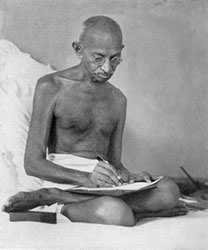
P.O. SEVAGRAM, DIST.WARDHA 442102, MS, INDIA. Phone: 91-7152-284753
FOUNDED BY MAHATMA GANDHI IN 1936
Short Stories For Everyone
Inspiring incidents from Gandhiji's Life: Selected from the book Everyone's Gandhi
(For the children in the age group of 10 to 15 years)

SHORT STORIES FOR EVERYONE
Gandhi's inspiring short stories selected from the book Everyone's Gandhi
Editor by : Rita Roy
Table of Contents
- All for A Stone
- A Car And A Pair of Binoculars
- My Master's Master
- Enter The Monkeys
- Premchand Quits His Job
- Returning His Medals
- Basic Pen
- Prisoner No. 1739
- Gandhi's White Brother
- Who Saw Gandhi?
- An Early School
- An Unusual March
- Spiritual Heir
- The Less You Have The More You Are
- An Old Goat Talks
- The Phoenix Settlement
- Gandhi in Amsterdam
- Something To Be Shy About?
- Gandhiji The Matchmaker
- Gandhi's Army
- Dandi Snippet
- Hiding Something
- The Image Maker
- Creative Reader
- Postcards To The Rescue
- A Non-violent Satyagraha 214 Years Ago
- Gandhi And Delhi
- Gandhiji's Constructive Programme
- Gandhi Looks At Leprosy
- Baba Amte
- They Gave Peace A Chance
- From Mahatma To God
- Customs Are Out of Fashion
- The Man 'Charlie' Wanted To Meet
- It Came Naturally To Him
- Crossing The Sea of Narrow-Mindedness
- Wear Clothes As They Should Be Worn
- Education: For Life, Through Life
- The Abode of Joy
- To Cling to A Belief
- The Fruit of A Child's Labour
- An Ideal Prisoner
- How A Film Became Something More
- Gandhi: Beyond India
- Gandhi's Life-Saving Medicine
- Understanding The Mechanics of Life With Gandhi
- The Lokmanya and The Mahatma
- Man's Gift To Nature
- Gurudev And His Mahatma
- One-man Boundary Force
- What Does Mahatma Gandhi's Message Mean To Me?
- Let's Play Together
- Children's Response To Conflict
- Beggar By Choice
- The Better Half
- Uncle Gandhi
- The Watch: An Instrument For Regulating Life
- Light The Lamp of Your Mind
- Gandhi's Bet!
- Gandhi Feeling At Home In The Kitchen
- What Is Simplicity?
- Bapu And The Sardar
- The Power of Quality
- Gandhi: The Teenager!
Chapter 40: To Cling to A Belief
As the world prepares to observe yet another Environment Day, our thoughts turn to Mahatma Gandhi, who, without ever using any of the modern jargons, was perhaps the greatest 'environmentalists' of our times. Gandhi knew that unless man lived in harmony with nature and unless he stopped exploiting nature he would certainly tread the path of destruction. In his own way, he talked of conservation and sustainability. His frame of non-violence comprehended non-violence to nature as much as to man.
In this column, we would like to take you twenty two years back in time, to a little village called Gopeshwar nestling in the Himalayas which saw the birth of a great movement - the Chipko.
Chipko! When the District Magistrate first heard the word, he smirked. But he could not laugh it away, knowing the strength of the Dashauli Gram Swarajya Sangh of Gopeshwar. The chief aim and objective of the Sangh was to stop the abuse of forests of Uttarakhand by contractors from plains and instead, use the forest resources for giving productive job opportunities to the local people.
It is no surprise that Chipko should be inspired by Gandhian ideals. The leader of the Chipko movement was Chandi Prasad Bhatt who belongs to the Gandhian school of thought.
The Symon Company of Allahabad, a manufacturer of sports goods, had been allotted some ash trees from the Mangal Forest which was barely 13 kilometers away from Gopeshwar. The Sangh resolved to fight for the rights of the people. Each passing day brought near the confrontation when the agents of the Symon Company were to come and take away the sanctioned trees.
In spite of warnings from the top, the policies and plans being pursued in the forests remained the same. After reading newspaper reports of the Indian floods due to rapid felling of trees, Miss Slade (Gandhiji's well known British disciple Mira Behn) wrote in an English daily of New Delhi expressing her concern. But who was there to listen?
In April 1973, a public meeting was held in the Dashauli Gram Swarajya Sangh's courtyard to decide on direct action against the Symon Company. The question was the same in every village, "How can we save the trees from being axed ?" That was the moment Chandi Prasad had been waiting for. "You can save the forest by cling to the trees, and dare them to let their axes fall on your backs, " he said. Startled at his suggestion one of the villagers exclaimed, "Can we really save such a big forest from being felled?" Chandi Prasad did not say anything. He was well aware that ultimately the success of the Chipko action depended on them. It took a while, but the meeting finally accepted the suggestion, though the village women sitting in the back kept laughing at the word "Chipko". Little did they know then that, one day, they the women, would have a great hand in saving the by holding them in their protective embrace.
Adapted from Chipko Movement
by Anupam Mishra and Satyendra Tripath